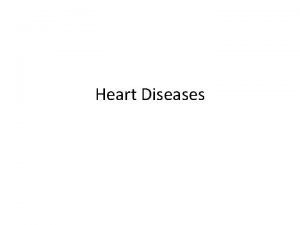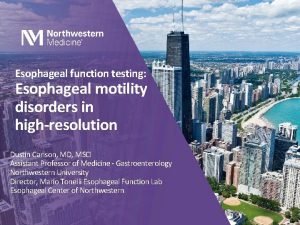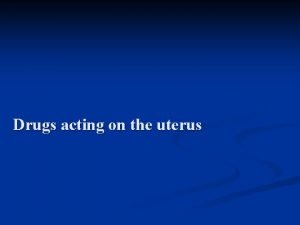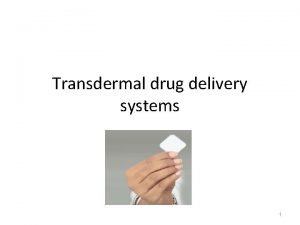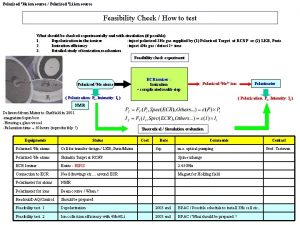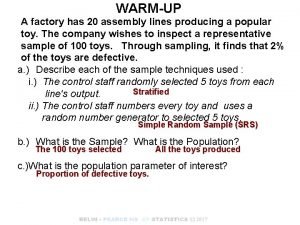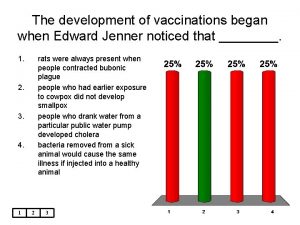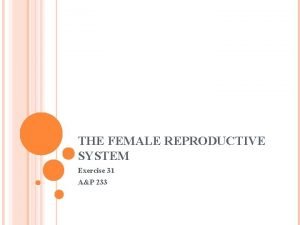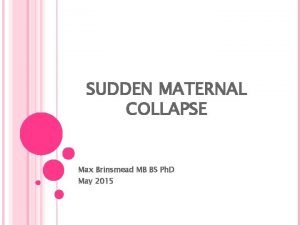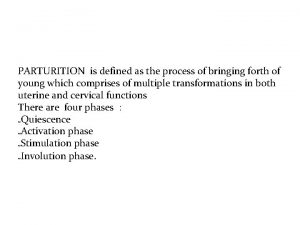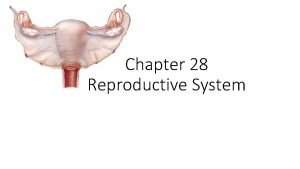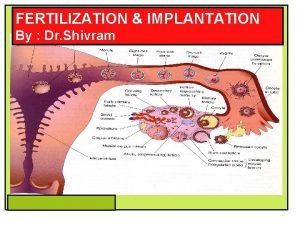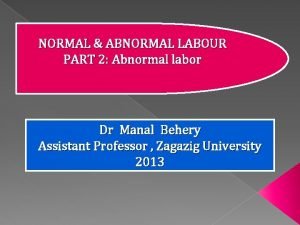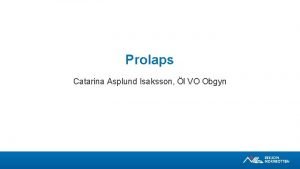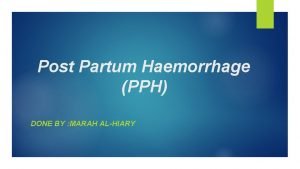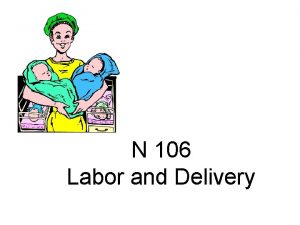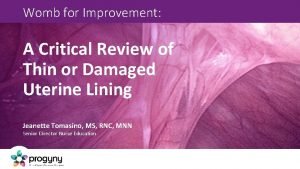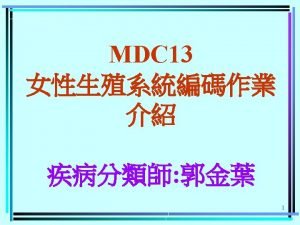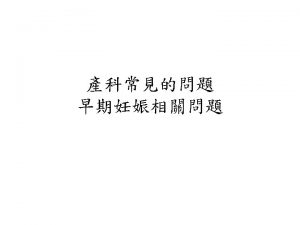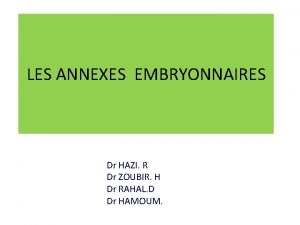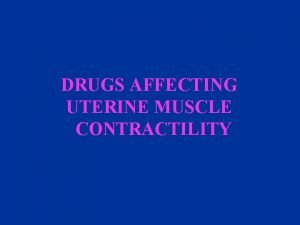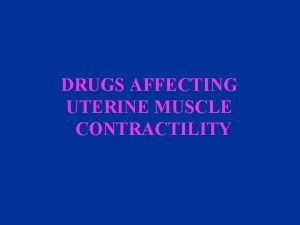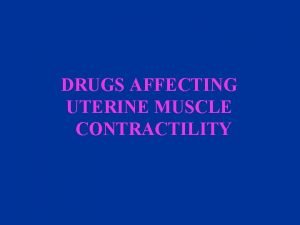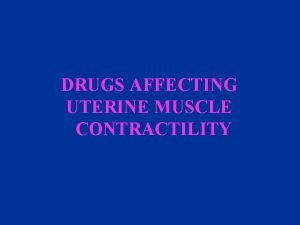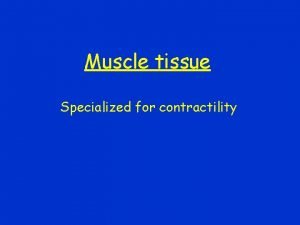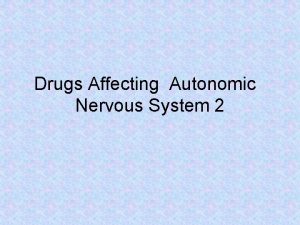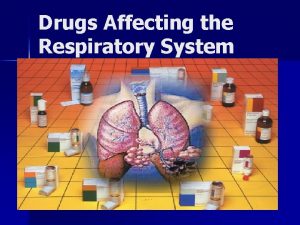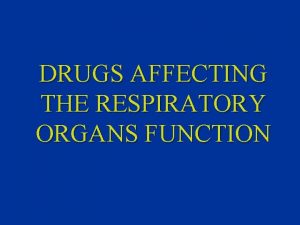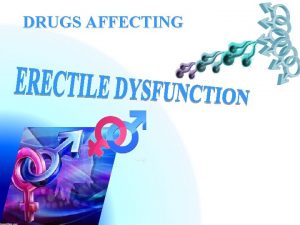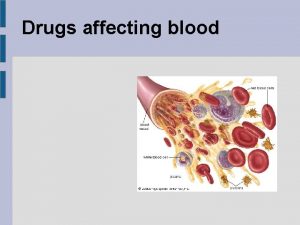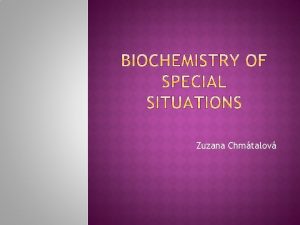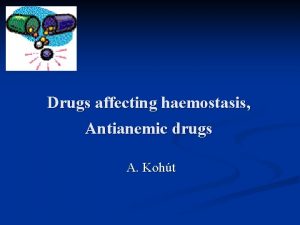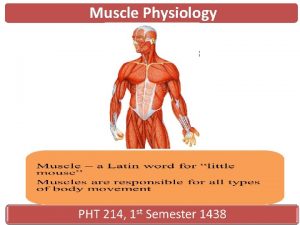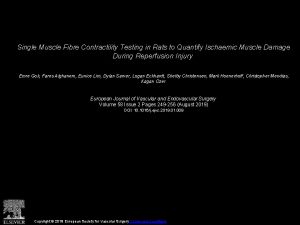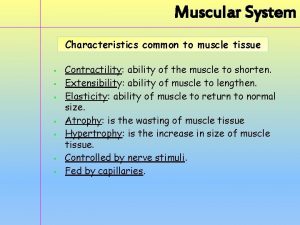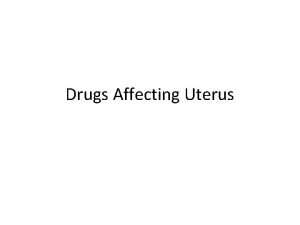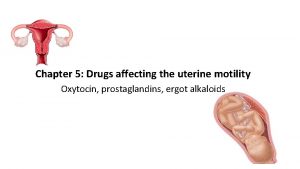DRUGS AFFECTING UTERINE MUSCLE CONTRACTILITY DRUGS PRODUCING UTERINE




































- Slides: 36

DRUGS AFFECTING UTERINE MUSCLE CONTRACTILITY

DRUGS PRODUCING UTERINE RACTIONS( Oxytocic Drugs ) 1. OXYTOCIN 2. ERGOT ALKALOIDS Ergometrine (Ergonovine) 3. PROSTAGLANDINS a) PGE 2 b) PGF 2α

OXYTOCIN (Syntocinon ) R Synthesis • Is a posterior pituitary hormone secreted by the posterior pituitary gland. • Oxytocin secretion occurs by sensory stimulation from cervix , vagina , and from suckling at breast.



Pharmacokinetics of oxytocin Absorption , Metabolism and Excretion • • • Not effective orally Administered intravenously Also as nasal spray Not bound to plasma proteins Catabolized by liver & kidneys Half life = 5 minutes

Role of oxytocin Uterus • Stimulates both the frequency and force of uterine contractility particularly of the fundus segment of the uterus. • These contractions resemble the normal physiological contractions of uterus (contractions followed by relaxation)


• Immature uterus is resistant to oxytocin. • Contract uterine smooth muscle only at term. • Sensitivity increases to 8 fold in last 9 weeks and 30 times in early labor. • Clinically oxytocin is given only when uterine cervix is soft and dilated.

Mechanism of action • The interaction of endogenous or administered oxytocin , with myometrial cell membrane receptor promotes the influx of ca ++ from extra cellular fluid and from S. R in to the cell , this increase in cytoplasmic calcium , stimulates uterine contraction.

Therapeutic Uses of Oxytocin 1. Induction & augmentation of labor** (slow I. V infusion) a) Mild preeclampsia b) Uterine inertia c) Incomplete abortion d) Post maturity e) Maternal diabetes

Therapeutic Uses of Oxytocin (continue) 2. Post partum uterine hemorrhage (I. V drip) 3. Impaired milk ejection One puff in each nostril 2 -3 min before nursing

Side Effects: a) b) c) d) e) Hypertension Uterine rupture Fetal death(ischaemia) Water intoxication Neonatal jaundice

Contraindications a) b) c) d) e) Hypersensitivity Prematurity Abnormal fetal position Evidence of fetal distress Cephalopelvic disproportion Precautions a) Multiple pregnancy b) Previous c- section c) Hypertension

Ergot Alkaloids • Ergometrine (Ergonovine) • Methylergonovine

Effects on the Uterus • Alkaloid derivatives induce TETANIC CONTRACTION of uterus without relaxation in between. These does not resemble the normal physiological contractions • It causes contractions of uterus as a whole i. e. fundus and cervix(tend to compress rather than to expel the fetus) Difference between oxytocin & ergots? ?


Ergot alkaloids( pharmacokinetics) • Absorption , fate and excretion • Absorbed orally from GIT(tablets) • Usually given I. M • Extensively metabolized in liver. • 90% of metabolites are excreted in bile

Clinical uses • Post partum hemorrhage (3 rd stage of labor)** When to give it? Preparations Syntometrine(ergometrine 0. 5 mg + oxytocin 5. 0 I. U), I. M.

Side effects a) b) b) c) Nausea, vomiting, diarrhea Hypertension Vasoconstriction of peripheral blood vessels ( toes & fingers) Gangrene

* Contraindications: a) 1 st and 2 nd stage of labor b) vascular disease c) impaired hepatic and renal functions * Precautions: a) Cardiac diseases b) Hypertension c) Multiple pregnancy

PROSTAGLANDINS (PGE 2 & PGF 2α) • MECHANISM OF ACTION: • Contract uterine smooth muscle Difference between PGS and Oxytocin: • PGS contract uterine smooth muscle not only at term(as with oxytocin), but throughout pregnancy. • PGS soften the cervix; whereas oxytocin does not. • PGS have longer duration of action than oxytocin.

• Therapeutic uses 1. Induction of abortion (pathological)** 2. Induction of labor (fetal death in utero) 3. Postpartum hemorrhage

• Side Effects a) b) c) d) e) Nausea , vomiting Abdominal pain Diarrhea Bronchospasm (PGF 2α) Flushing (PGE 2)

• Contraindications: a) Mechanical obstruction of delivery b) Fetal distress c) Predisposition to uterine rupture • Precautions: a) Asthma b) Multiple pregnancy c) Glaucoma d) Uterine rupture

Difference B/w Oxytocin and Prostaglandins Character Oxytocin Prostaglandins Contraction Only at term Contraction through out pregnancy Cervix Does not soften the cervix

Difference (cont’d) Character Oxytocin Prostaglandins Duration of action Shorter Longer uses Not used for abortion Used for abortion in 2 nd trimester of pregnancy. Used for induction and augmentation of labor and post partum hemorrhage Used as vaginal suppository for induction of labor

Difference b/w Oxytocin and Ergometrine Character Oxytocin Ergometrine Contractions Resembles normal physiological contractions Tetanic contraction ; doesn't resemble normal physiological contractions Uses Only in P. partum hemorrhage Onset and Duration *To induce &augment labor. *Post partum hemorrhage Rapid onset Shorter duration of action Moderate onset Long duration of action

UTERINE RELAXANTS

DRUGS PRODUCING UTERINE RELAXATION( Tocolytic Drugs ). Action and Uses Relax the uterus and arrest threatened abortion or delay premature labor. 1. β-ADRENOCEPTOR AGONISTS** Ritodrine, i. v. drip Selective β 2 receptor agonist used specifically as a uterine relaxant.

β- adrenoceptor agonists • Mechanism of action Bind to β-adrenoceptors , activate enzyme Adenylate cyclase , increase in the level of c. AMP reducing intracellular calcium level and decreasing the sensitivity of actin myosin contractile unit.

• Side effects: • Tremor • Nausea , vomiting • Flushing • Sweating • Tachycardia (high dose) • Hypotension • Hyperglycemia • Hypokalaemia

2. CALCIUM CHANNEL BLOCKERS e. g. , Nifedipine • Causes relaxation of myometrium • Markedly inhibits the amplitude of spontaneous and oxytocin-induced contractions

• Unwanted effects • • Headache, dizziness Hypotension Flushing Constipation Ankle edema Coughing Wheezing Tachycardia

3. Prostaglandin synthetase inhibitors • The depletion of prostaglandins prevents stimulation of uterus NSAID, s e. g. Aspirin Indomethacin Ibuprofen

Adverse effects ulceration • premature closure of ductus arterious.
 Decreased contractility
Decreased contractility Chicago classification manometry
Chicago classification manometry Uterine stimulants definition
Uterine stimulants definition Rate of elimination of drug
Rate of elimination of drug Factors affecting dermal penetration of drugs
Factors affecting dermal penetration of drugs Smooth muscle cell
Smooth muscle cell What muscle fibers run in circles around your eye
What muscle fibers run in circles around your eye Gametophytes have gamete-producing organs called _____.
Gametophytes have gamete-producing organs called _____. An ion source is producing 6li ions
An ion source is producing 6li ions Fixed asset turnover ratio
Fixed asset turnover ratio Process specification diagram
Process specification diagram The molecules used to cut copy and connect the dna
The molecules used to cut copy and connect the dna Situation relating questions in research examples
Situation relating questions in research examples A goal of producing process specifications is to
A goal of producing process specifications is to A goal of producing process specifications is to:
A goal of producing process specifications is to: A factory has 20 assembly lines producing
A factory has 20 assembly lines producing Producing for dummies
Producing for dummies Advantages of gymnosperms
Advantages of gymnosperms Edward jenner
Edward jenner Structured decision in system analysis and design
Structured decision in system analysis and design Kumar is producing the photoelectric effect by using
Kumar is producing the photoelectric effect by using Uterine volume by age
Uterine volume by age Uterine tube
Uterine tube Uterine inversion
Uterine inversion Upper uterine segment
Upper uterine segment Uterine irritability
Uterine irritability Prepuce
Prepuce Uterine cavity
Uterine cavity Normal and abnormal labour
Normal and abnormal labour Prolaberat
Prolaberat Uterotonics
Uterotonics Uterine inversion
Uterine inversion Ignant review womb for improvement
Ignant review womb for improvement Left uterine displacement
Left uterine displacement Uterus
Uterus B lynch suture
B lynch suture Coque trophoblastique
Coque trophoblastique
